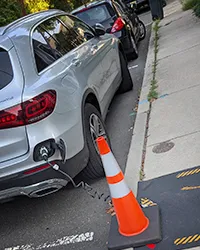
2025 is shaping up to be a pivotal year for the EV and EV charger markets. While the past few years have seen significant growth, recent changes in federal policy and rising consumer uncertainty are creating a more volatile landscape. However, rebate programs continue to offer valuable opportunities for those who can navigate the shifting terrain effectively.
Since January of last year, there has been a 46% growth in Level 2 charging ports and an 83% increase in DCFC ports across the country. However, studies and surveys indicate that infrastructure still struggles to keep pace with demand. According to Cox Automotive, US new electric vehicle sales in January rose by 29.9% year over year.
We have been examining the changes in rebate programs for EVSE, which have proven to be a key part of the sales process, to see how they have evolved for 2025. The results may be surprising.
EV Charger Rebate Program Coverage Has Increased
Currently, 78% of the US is covered by an active program for EV chargers. This is a significant increase from the 60% coverage we saw in 2022 and 2023 and just shy of the 80% we saw last year. This growth in coverage is a positive sign for the continued support of EV infrastructure.

It's not just the geographical coverage that has increased. The number of open programs has also seen a significant 11% increase between 2024 and 2025. As of today, nearly 500 different programs are open and accepting applications for EV chargers.

The numbers might be surprising, given the recent news coverage and public perceptions. But much of the reporting has focused on federal initiatives, only one of five sources for EV charger incentive programs. Funding for these programs also comes from states, counties, municipalities, and electric utilities. These programs are less affected by changes at the federal level because the funding is provided directly by state governments or they are ratepayer-funded programs.

In the grand scheme of things, incentives for EV chargers are still relatively new, making it difficult to predict their long-term future. However, if we examine energy efficiency incentive programs that have existed since the 1980s, we can observe a similar trend. These programs have continued to thrive despite numerous changes in administration, evolving and adapting over time. This history suggests that it would be premature to assume that all funding sources for EV chargers will disappear in the near future.
Level 2 Rebates Rise While DCFC Sees a Modest Dip
Rebate coverage is important, but so are the dollar amounts. Rebates for EV chargers typically cover a large portion of the cost and are key to making a business case for the installation of a charger.

For Level 2 chargers, the rebates increased since last year. The average rebate for residential/personal-use chargers increased by 10% to $581. Similarly, the average incentive for commercial Level 2 chargers increased by 16% to $2,638.
DCFC / Level 3 chargers are a different story, but not wholly negative. The average incentive decreased slightly by 3% to $19,649. However, this number may be a bit misleading, as it only includes prescriptive, or set, rebate amounts. For DCFC, make-ready costs represent a significant portion of the total project cost. Some rebate programs will cover these costs, but they’re set as a percentage of make-ready costs rather than a fixed amount. In some cases, make-ready incentives can even be stacked with the charger incentives, making the incentives more lucrative.
| Charger Type | Average Rebate Amount | Change from Last Year |
|---|---|---|
| Residential Level 2 Chargers | $581 | +10% |
| Commercial Level 2 Chargers | $2,638 | +16% |
| DCFC / Level 3 Chargers | $19,649 | -3% |
| Source: RebatePro for EV Chargers, March 2025 | ||
Federal Programs Prove Unpredictable

Federal funding has been a crucial driver for EV charger installations, but these programs have dominated headlines recently due to political actions and general uncertainty. Programs like NEVI funding and the 30C Federal Tax Credit face potential disruptions, making it more important than ever to understand the evolving landscape.
NEVI Funding
The programs that are most at risk are those that use NEVI funding. NEVI funding is $5 billion in Federal monies set aside as part of the “Infrastructure Investment and Jobs Act” to increase public charging infrastructure across the nation's highways. These incentives are for DCFC / Level 3 charging within one travel mile of the nation's busiest corridors.
In January, an Executive Order “Unleashing American Energy” was issued, specifically freezing funds for NEVI-funded rebate programs. The ambiguity of the order created uncertainty about the impact on these programs. Later, in February, a memo from the US Department of Transportation Federal Highway Administration provided more guidance, stating, “reimbursement of existing obligations will be allowed,” but “no new obligations may occur under the NEVI Formula Program until the updated final NEVI Formula Program Guidance is issued.”
Since NEVI programs are developed and administered individually by each state, their responses have varied. Some states have paused new rounds of funding, while others continue to accept submissions but are holding them for review until they receive further guidance.
US 30C Federal Tax Credit
Another US Federal Program that is at risk is the 30C Federal Tax Credit. This program offers a tax credit of up to $1,500 for residential applications and $100,000 for commercial (capped at 30% of the cost). This tax credit cannot be rescinded by Executive Order, but legislation called “The ELITE Vehicles Act” was introduced in mid-February that would discontinue the incentives if passed. Currently, the 30C Federal Tax Credit remains available, and the proposed bill states the credits will end 30 days after being signed into law.
While federal funds have been significant, it’s important to remember that they are only one potential source of funding. A wide range of state, local, and utility incentives remain available, offering valuable alternatives.
Technical Standards and Approved Chargers
Choosing the right EV charger to get a rebate can also be challenging. 23% of all rebates require that you use a charger from an Approved Product List (APL). That's up 2% from last year. In addition, commercial applications may also require that the charger is connected to an approved network, with 13% of rebates having an Approved Network List.

In an effort to make their requirements easier to understand, a few programs have shifted to the EPRI list, but that represents just a handful of the nearly 500 programs available. This list isn’t a certification like EnergyStar but rather a reference that contains different certifications and qualifications programs might require. Because of that, you won't see an “EPRI-approved charger” label as you might see “EnergyStar-approved refrigerator.”
Some of the hardware and software requirements that are becoming more popular are ISO 15118 and OCPP, which provide a more seamless user experience with features like “plug and charge.” For example, any charger that wants to receive a make-ready rebate in NY state must be ISO 15118-2 or -20 and OCPP 2.0.1 or later for DCFC (and Level 2 after June 1). Still, these requirements are by no means standardized across all programs; you must pay close attention to the specific program you’re working with.
Beyond Chargers: Incentives for Electric Vehicles

For any company considering adding electric vehicles (EVs) to their fleets, it’s important to remember that funding is also available. While the current electric vehicle tax credits would also be revoked by “The ELITE Vehicles Act,” as of now, they are still in place. But in addition to the Federal Tax Credit, other rebates, incentives, and grants are available from states, utilities, and municipalities.
BriteSwitch recently introduced a new tool containing incentives for electric vehicles themselves and saw that 64% of the US currently is covered by an incentive for an EV. The rebate will vary depending on the type of drive train, vehicle type, and usage, but it's still a very valuable incentive to take advantage of.
| Vehicle Type | Average Rebate Amount |
|---|---|
| Passenger Car (BEV) | $4,673 |
| Medium/Heavy Duty Truck (BEV) | $92,539 |
| School Bus (BEV) | $115,250 |
| Passenger Car (PHEV) | $2,590 |
| Shuttle/Transit Van/Bus (BEV) | $107,334 |
| Source: RebatePro for Electric Vehicles, March 2025 | |
EV Charger Incentives Are Crucial in 2025
2025 will likely be a challenging year for the EV and EVSE industry, making rebates and incentives more important than ever. They play a huge role in the sales cycle and in making a solid business case for EV charger installations. These incentives typically cover a substantial part of the cost, making these investments more attractive in an early market.
While these programs are volatile, they are as strong as ever. For those in the industry, knowing how to utilize these incentives is vital to succeeding. Whether it's including the information on quotes or helping customers capture the rebates, companies that leverage EV charger rebates will be the most successful. Make sure to investigate all possible rebates and incentives when evaluating EVSE projects. Once estimated, you also have to be vigilant about monitoring any changes in the programs and stay on top of any application deadlines and requirements.

